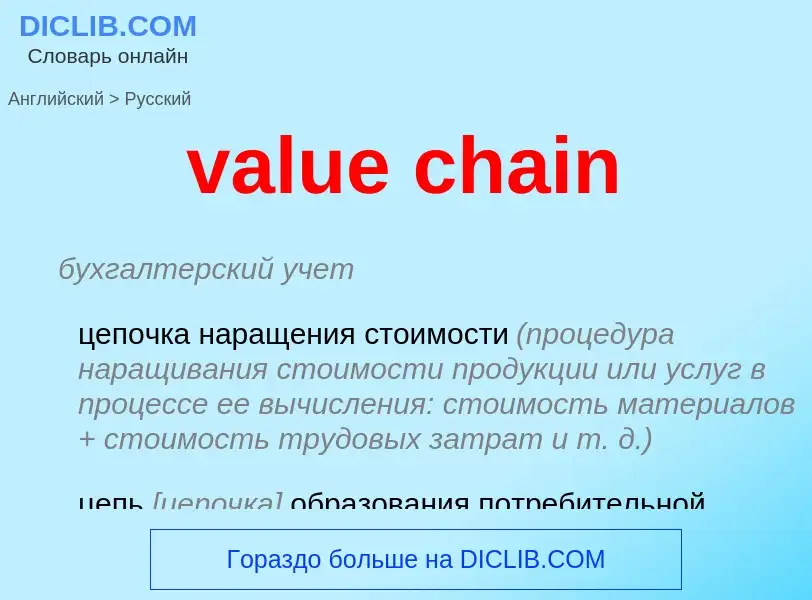Translation and analysis of words by ChatGPT artificial intelligence
On this page you can get a detailed analysis of a word or phrase, produced by the best artificial intelligence technology to date:
- how the word is used
- frequency of use
- it is used more often in oral or written speech
- word translation options
- usage examples (several phrases with translation)
- etymology
value chain - translation to russian
бухгалтерский учет
цепочка наращения стоимости (процедура наращивания стоимости продукции или услуг в процессе ее вычисления: стоимость материалов + стоимость трудовых затрат и т. д.)
цепь [цепочка] образования потребительной стоимости (последовательность операций или действий по созданию стоимости изделия (по преобразованию исходных материалов в конечный продукт); как правило, имеет следующие составляющие: исследования и разработки, дизайн продукта, производство, маркетинг, сбыт, послепродажное обслуживание)
общая лексика
мерная цепь
Definition
Wikipedia
A value chain is a progression of activities that a firm operating in a specific industry performs in order to deliver a valuable product (i.e., good and/or service) to the end customer. The concept comes through business management and was first described by Michael Porter in his 1985 best-seller, Competitive Advantage: Creating and Sustaining Superior Performance.
The idea of the value chain is based on the process view of organizations, the idea of seeing a manufacturing (or service) organization as a system, made up of subsystems each with inputs, transformation processes and outputs. Inputs, transformation processes, and outputs involve the acquisition and consumption of resources – money, labour, materials, equipment, buildings, land, administration and management. How value chain activities are carried out determines costs and affects profits.
The concept of value chains as decision support tools, was added onto the competitive strategies paradigm developed by Porter as early as 1979. In Porter's value chains, Inbound Logistics, Operations, Outbound Logistics, Marketing and Sales, and Service are categorized as primary activities. Secondary activities include Procurement, Human Resource management, Technological Development and Infrastructure (Porter 1985, pp. 11–15).
According to the OECD Secretary-General (Gurría 2012) the emergence of global value chains (GVCs) in the late 1990s provided a catalyst for accelerated change in the landscape of international investment and trade, with major, far-reaching consequences on governments as well as enterprises (Gurría 2012).

